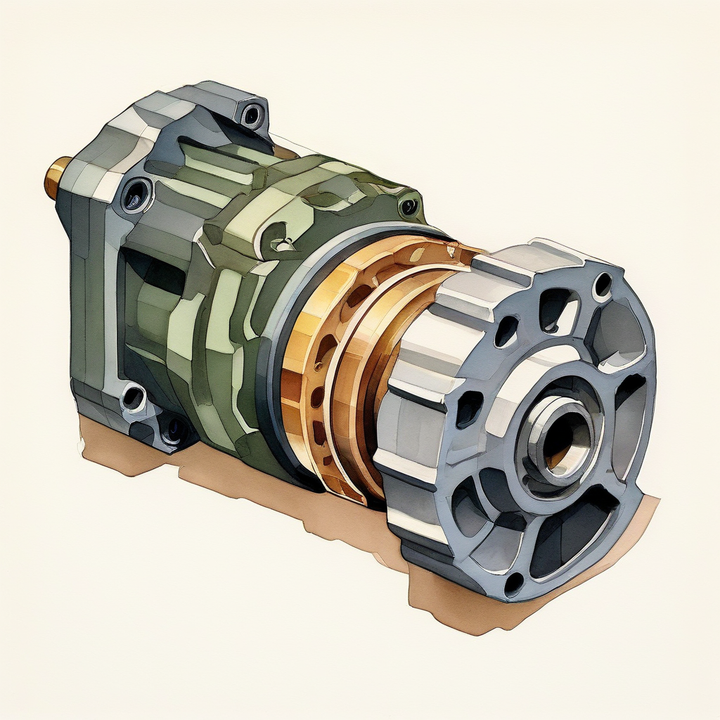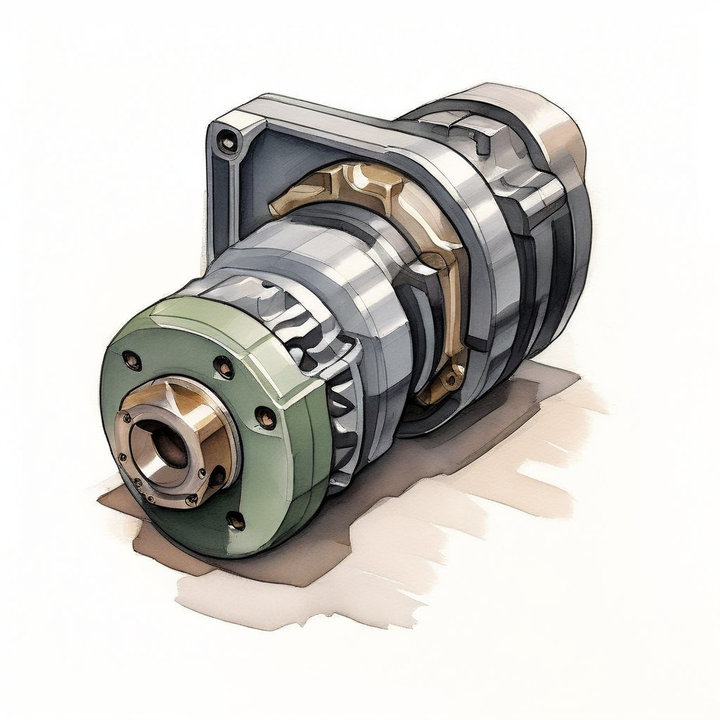


The OBD-II trouble code P03EF indicates an issue with the "A" Camshaft Profile Actuator C Control Performance/Stuck Off in Bank 1. This code is related to the camshaft profile control system, which is responsible for adjusting the camshaft's position to optimize engine performance.
Before we dive into the nitty-gritty of the P03EF code, let's take a moment to appreciate the ingenious engineering behind the camshaft profile actuator, also known as the variable valve timing (VVT) system.
| Component | Function |
|---|---|
| Camshaft Profile Actuator | Adjusts the timing of the engine's valves |
| Powertrain Control Module (PCM) / Engine Control Module (ECM) | Sends signals to the actuator to control valve timing |
This nifty little component is responsible for adjusting the timing of your engine's valves, ensuring optimal performance, fuel efficiency, and emissions control. The camshaft profile actuator is essentially a solenoid that receives signals from the PCM or ECM. These signals instruct the actuator to advance or retard the camshaft timing, allowing the engine to operate at its peak efficiency across a wide range of operating conditions.
Now, let's get to the heart of the matter – the causes behind the dreaded P03EF code. As with most automotive issues, there's rarely a single culprit, but rather a constellation of potential factors that can trigger this code.
Proper engine oil maintenance is crucial for the smooth operation of the VVT system. Using incorrect oil specifications, low oil levels, or contaminated oil can lead to sludge buildup, restricting oil flow to the camshaft actuators.
Incorrect oil specification
Low oil levels
Contaminated oil
Sludge buildup
The camshaft profile actuator itself can get stuck in an open or closed position due to mechanical failure or sludge buildup, preventing proper camshaft timing adjustments.
Mechanical failure
Sludge buildup
Stuck in open or closed position
Damaged wiring, loose connections, or electrical shorts in the camshaft profile actuator circuit can disrupt the communication between the actuator and the PCM/ECM, causing erratic behavior or failure.
Damaged wiring
Loose connections
Electrical shorts
Internal mechanical issues within the camshaft profile actuator, such as worn components or manufacturing defects, can lead to performance problems or a stuck condition.
Worn components
Manufacturing defects
Internal mechanical issues
Problems with the powertrain control module or engine control module, such as software glitches or hardware failures, can result in incorrect signals being sent to the camshaft profile actuator.
Software glitches
Hardware failures
Incorrect signals
Now that we've identified the potential culprits, it's time to roll up our sleeves and dive into the diagnostic process. Here's how I approach this code:
Scan for Additional Codes
Scan for any additional trouble codes related to the VVT system, wiring, or PCM/ECM
These codes can provide valuable clues and help narrow down the root cause
Oil Inspection
Check the engine oil level, condition, and specification
If the oil is low, contaminated, or doesn't meet the manufacturer's recommendations, it's time for an oil change and possibly an engine flush
Wiring Inspection
Inspect the wiring harness and connectors for the camshaft profile actuator circuit
Look for any signs of damage, corrosion, or loose connections
Visual Inspection
Perform a visual inspection of the camshaft profile actuator itself
Check for any signs of mechanical failure, sludge buildup, or other physical damage
Diagnostic Tools
Use a diagnostic scanner or lab scope to monitor the camshaft profile actuator operation
Check for proper signal patterns from the PCM/ECM
During the diagnostic process, I've learned to recognize certain telltale signs that can point to specific failures within the camshaft profile actuator system.
| Failure Type | Symptoms |
|---|---|
| Stuck Actuator | Rattling noises, low power, altered power bands, poor drivability |
| Wiring Issues | Intermittent or erratic actuator operation, other electrical system issues |
| PCM/ECM Problems | Misfires, rough idling, other engine management system issues |
If the actuator is stuck, you might hear rattling noises from the engine, experience low power or altered power bands, and notice poor drivability symptoms. It's like having a stuck accelerator pedal – not a pleasant experience.
Intermittent or erratic operation of the camshaft profile actuator, along with other electrical system issues, can often indicate wiring problems. It's like trying to watch a movie with a faulty cable connection – frustrating and unpredictable.
When the PCM/ECM is the culprit, you might experience other engine management system issues, such as misfires or rough idling, accompanying the camshaft profile actuator code. It's like having a faulty computer trying to run multiple programs simultaneously.
Once the root cause has been identified, it's time to roll up our sleeves and get our hands dirty with the repair process.
Locate and remove the camshaft profile actuator/VVT solenoid following the manufacturer's instructions
Clean the actuator and surrounding area thoroughly to remove any sludge buildup
If the actuator is damaged or stuck, replace it with a new one specified for your vehicle make and model
Reinstall the new actuator, ensuring proper connections and routing of the wiring harness
Locate and repair any damaged wiring or loose connections in the camshaft profile actuator circuit
If necessary, replace the entire wiring harness or connectors according to the manufacturer's recommendations
If the issue persists after replacing the actuator and repairing the wiring, the PCM/ECM may need to be reprogrammed, updated, or replaced by an authorized dealer or repair facility.
Always follow the manufacturer's recommended procedures and torque specifications when working on the camshaft profile actuator system
Ensure that the correct engine oil specification and viscosity are used after repairs
If the engine has excessive sludge buildup, consider performing an engine flush or replacement to prevent future issues
Prevention is always better than cure, and when it comes to the camshaft profile actuator system, there are a few simple steps you can take to prevent the recurrence of this issue.
Maintain proper engine oil levels and follow the recommended oil change intervals using the correct oil specification for your vehicle
Avoid excessive idling or short trip driving, which can contribute to sludge buildup
Have the vehicle's electrical system inspected regularly for any wiring issues or loose connections
Consider installing an oil catch can or air-oil separator to reduce the amount of blow-by entering the engine
Repairs can often come with a hefty price tag, and the camshaft profile actuator system is no exception. Here are some approximate cost estimates to give you an idea of what you might be looking at:
| Repair Type | Approximate Cost |
|---|---|
| Camshaft Profile Actuator/VVT Solenoid Replacement | $200 - $500 for the part, plus labor costs |
| Wiring Harness or Connector Replacement | $100 - $300 for the part, plus labor costs |
| PCM/ECM Reprogramming or Replacement | $300 - $1,000 or more, depending on the vehicle and repair facility |
While these costs might seem daunting, it's important to remember that neglecting this issue can lead to further engine damage and even more expensive repairs down the line. Think of it as an investment in your vehicle's longevity and performance.
We've covered a lot of ground today, haven't we? From understanding the inner workings of the camshaft profile actuator system to diagnosing and repairing the P03EF code, we've explored the depths of this automotive enigma.
Remember, as a mechanic, my job is not just to fix cars but also to educate and empower you, the vehicle owner, with knowledge. By understanding the intricacies of your vehicle's systems, you can make informed decisions and take proactive steps to prevent issues before they arise.
So, the next time you encounter the P03EF code or any other automotive conundrum, don't panic. Embrace the challenge, roll up your sleeves, and tackle it head-on, armed with the knowledge and expertise you've gained today.
Happy motoring, my friends, and may your camshaft profile actuators always operate smoothly and efficiently!
The camshaft profile actuator, also known as the variable valve timing (VVT) system, adjusts the timing of the engine's valves to ensure optimal performance, fuel efficiency, and emissions control.
The powertrain control module (PCM) or engine control module (ECM) sends signals to the camshaft profile actuator, instructing it to advance or retard the camshaft timing.
You may hear rattling noises from the engine, experience low power or altered power bands, and notice poor drivability symptoms if the actuator is stuck.
Yes, damaged wiring, loose connections, or electrical shorts in the camshaft profile actuator circuit can disrupt communication and trigger the P03EF code.
Inspect the wiring harness and connectors for any damage, corrosion, or loose connections, and use a diagnostic scanner to monitor the actuator's operation.
Consider performing an engine flush or replacement to prevent future issues with the camshaft profile actuator system.
Yes, software glitches or hardware failures in the PCM/ECM can result in incorrect signals being sent to the camshaft profile actuator, causing the P03EF code.
The cost can range from $200 to $500 for the part, plus labor costs.
Maintain proper engine oil levels, follow recommended oil change intervals, avoid excessive idling, and have the vehicle's electrical system inspected regularly.
Yes, neglecting this issue can lead to further engine damage and more expensive repairs in the long run.

Miguel started tinkering with car radios as a teenager, fascinated by the intricate dance of wires and circuits. This passion led him to pursue a career as an automotive electrician. For the past 10 years, Miguel has tackled everything from flickering headlights to mysterious electrical gremlins. He thrives on troubleshooting electrical problems and enjoys sharing his knowledge to empower car owners to understand their vehicles better.



